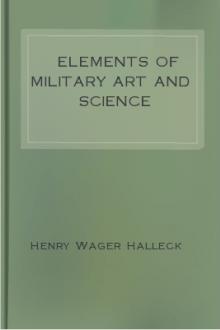Elements of Military Art and Science by Henry Wager Halleck (books you have to read txt) 📕

- Author: Henry Wager Halleck
- Performer: -
Book online «Elements of Military Art and Science by Henry Wager Halleck (books you have to read txt) 📕». Author Henry Wager Halleck
Bousmard, a French emigrant, published in 1790. He adopted the general trace of Vauban, but introduced modifications in the details essentially different from those of Cormontaigne. Some of these modifications are very valuable improvements, while others are of a more doubtful character. Bousmard is, on the whole, a very able writer, and his works should be found in the library of every military engineer.
Carnot's celebrated treatise was published in 1810. He was evidently a man of genius, and during his career at the head of the War Department of France, numerous and very important improvements were made in the several branches of the military art, and especially in strategy. His work on fortification exhibits much originality and genius, but it is doubtful whether it has very much contributed to the improvement of this art. His ideas have been very severely, and rather unfairly criticised by the English, and particularly by Sir Howard Douglas.
Chasseloup de Laubat early distinguished himself as an engineer of much capacity and talent. He followed Napoleon in nearly all his campaigns, and conducted many of his sieges. He remodelled the fortifications of Northern Italy and of the Lower Rhine. He published in 1811. The improvements which he introduced are numerous and valuable, and he probably contributed more to advance his art, and to restore the equilibrium between attack and defence, than any other engineer since Cormontaigne. After the fall of Napoleon and the partition of his empire, the allies mutilated or destroyed the constructions of Chasseloup, so that, it is believed, no perfect specimen of his system remains.
The cotemporaries of Chasseloup were mostly engaged in active field service and sieges, and few had either leisure or opportunity to devote themselves to improvements in permanent fortification.
Choumara published in 1827. His system contains much originality, and his writings give proof of talent and genius. He has very evidently more originality than judgment, and it is hardly probable that his system will ever be generally adopted in practice.
The Metz system, as arranged by Noizet, as a theoretical study, is undoubtedly the very best that is now known. It, however, requires great modifications to suit it to different localities. For a horizontal site, it is probably the most perfect system ever devised. It is based on the system of Vauban as improved by Cormontaigne, and contains several of the modifications suggested by modern engineers. It is applied in a modified form to the new fortifications of Paris.
Baron Rohault de Fleury has introduced many modifications of the ordinary French system in his new defences of Lyons. We have seen no written account of these works, but from a hasty examination in 1844, they struck us as being too complicated and expensive.
The new fortifications of Western Germany are modifications of Rempler's system, as improved by De la Chiche and Montalembert. It is said that General Aster, the directing engineer, has also introduced some of the leading principles of Chasseloup and Carnot.
The English engineers have satisfied themselves with following in the track of their continental neighbors, and can offer no claims to originality.
Of the system of fortification now followed in our service we must decline expressing any opinion; the time has not yet arrived for subjecting it to a severe and judicious criticism. But of the system pursued previous to 1820, we may say, without much fear of contradiction, that a worse one could scarcely have been devised. Instead of men of talent and attainments in military science, most of our engineers were then either foreigners, or civilians who owed their commissions to mere political influence. The qualifications of the former were probably limited to their recollection of some casual visit to two or three of the old European fortresses; and the latter probably derived all their military science from some old military book, which, having become useless in Europe, had found its way into this country, and which they had read without understanding, and probably without even looking at its date. The result was what might have been anticipated—a total waste of the public money. We might illustrate this by numerous examples. A single one, however, must suffice. About the period of the last war, eight new forts were constructed for the defence of New York harbor, at an expense of some two millions of dollars. Six of these were circular, and the other two were star forts—systems which had been discarded in Europe for nearly two thousand years! Three of these works are now entirely abandoned, two others are useless, and large sums of money have recently been expended on the other three in an attempt to remedy their faults, and render them susceptible of a good defence. Moreover, a number of the works which were constructed by our engineers before that corps was made to feel the influence of the scientific education introduced through the medium of the Military Academy—we say, a considerable number of our fortifications, constructed by engineers who owed their appointment to political influence, are not only wrong in their plans, but have been made of such wretched materials and workmanship that they are already crumbling into ruins.
A fortification, in its most simple form, consists of a mound of earth, termed, the rampart, which encloses the space fortified; a parapet, surmounting the rampart and covering the men and guns from the enemy's projectiles; a scarp wall, which sustains the pressure of the earth of the rampart and parapet, and presents an insurmountable obstacle to an assault by storm; a wide and deep ditch, which prevents the enemy from approaching near the body of the place; a counterscarp wall, which sustains the earth on the exterior of the ditch; a covered way, which occupies the space between the counterscarp and a mound of earth called a glacis, thrown up a few yards in front of the ditch for the purpose of covering the scarp of the main work.
The work by which the space fortified is immediately enveloped, is called the enceinte, or body of the place. Other works are usually added to the enceinte to strengthen the weak points of the fortification, or to lengthen the siege by forcing the enemy to gain possession of them before he can breach the body of the place: these are termed outworks, when enveloped by the covered way, and advanced works, when placed exterior to the covered way, but in some way connected with the main work; but if entirely beyond the glacis, and not within supporting distance of the fortress, they are called detached works.
In a bastioned front the principal outwork is the demi-lune, which is placed in front of the curtain; it serves to cover the main entrance to the work, and to place the adjacent bastions in strong re-enterings.
The tenaille is a small low work placed in the ditch, to cover the scarp wall of the curtain and flanks from the fire of the besieger's batteries erected along the crest of the glacis.
The places of arms, are points where troops are assembled in order to act on the exterior of the work. The re-entering places of arms, are small redans arranged at the points of junction of the covered ways of the bastion and demi-lune. The salient places of arms are the parts of the covered way in front of the salients of the bastion and demi-lune.
Small permanent works, termed redoubts, are placed within the demi-lune and re-entering places of arms for strengthening those works. Works of this character constructed within the bastion are termed interior retrenchments; when sufficiently elevated to command the exterior ground, they are called cavaliers.
Caponniers are works constructed to cover the passage of the ditch from the tenaille to the gorge of the demi-lune, and also from the demi-lune to the covered way, by which communication may be maintained between the enceinte and outworks.
Posterns are underground communications made through the body of the place or some of the outworks.
Sortie-passages are narrow openings made through the crest of the glacis, which usually rise in the form of a ramp from the covered way, by means of which communication may be kept up with the exterior. These passages are so arranged that they cannot be swept by the fire of the enemy. The other communications above ground are called ramps, stairs, &c.
Traverses are small works erected on the covered way to intercept the fire of the besieger's batteries.
Scarp and counterscarp galleries are sometimes constructed for the defence of the ditch. They are arranged with loop-holes, through which the troops of the garrison fire on the besiegers when they have entered the ditch, without being themselves exposed to the batteries of the enemy.
In sea-coast defences, and sometimes in a land front for the defence of the ditch, embrasures are made in the scarp wall for the fire of artillery; the whole being protected from shells by a bomb-proof covering over head: this arrangement is termed a casemate.
Sometimes double ramparts and parapets are formed, so that the interior one shall fire over the more advanced; the latter in this case is called a faussebraie.
If the inner work be separated from the other it is called a retrenchment[44] and if in addition it has a commanding fire, it is termed, as was just remarked, a cavalier.
[44]
The term retrenchment implies an interior work, which is constructed within or in rear of another, for the purpose of strengthening it; the term intrenchment, on the contrary, implies an independent work, constructed in the open field, without reference to any other adjoining work.
The capital of a bastion is a line bisecting its salient angle. All the works comprehended between the capitals of two adjacent bastions is termed a front: it is taken as the unit in permanent fortification.
Fig. 39 represents the ground plan of a modern bastioned front, of a regular and simple form, on a horizontal site.
A, A, A—Is the enceinte, or body of the place.
B—The bastions.
C—The main ditch.
D—The covered ways.
E—The re-entering places of arms.
F—The salient places of arms.
G—The demi-lune.
H—The demi-lune ditch.
J—The demi-lune redoubt.
L—The ditch of the demi-lune
redoubt.
M—The redoubt of the re-entering
places of arms.
N—The ditches of the redoubts.
O—The tenaille.
P—The double caponier.
a—The traverses.
b—The sortie-passages.
c—Stairs.
d—Cut in the demi-lune to flank
the redoubt of the re-entering
place of arms.
Fig. 40 represents a section through the line mn' of the preceding figure.
A—Is the rampart.
B—The parapet.
C—The ditch.
D—The scarp wall.
E—The counterscarp wall.
F—The glacis.
G—The covered way.
H—The terre-plain.
J—The parade.
Sometimes half embrasures are cut in the earthen parapet of a fort, so as to sink the gun below the crest, and thus more effectually cover the men from the enemy's fire.
But guns in embrasure have a far less extended field of fire than when mounted in barbette; moreover, the embrasures present openings through which an enemy may penetrate in an assault. Owing to these objections, they are employed only for the protection of particular points; that is, where it is important to cover the artillerists from the enemy's fire, or where the guns are to be used merely to protect a ditch, or to enfilade a road, &c. The bottom of the embrasure is called the sole, the sides are called cheeks, and the mass of earth between two embrasures, the merlon. Embrasures may be made either direct or oblique, according as the fire is required to be perpendicular or oblique to the parapet.
A coverport is a small outwork of any convenient form, erected immediately in front of a gateway, to screen it from the enemy's fire.
A counterguard is a more extensive work, constructed in front of a part of the fortress itself, or of some other outwork of greater importance, which it is intended to cover. These are sometimes called coverfaces, from their situation and object; but the former term is most commonly used.
Sometimes outworks, called tenaillons, consisting of





Comments (0)